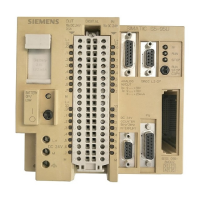Program instructions
7.3 Communication
S7-200 SMART
System Manual, V2.3, 07/2017, A5E03822230-AF
219
You use the TCON instruction to set up and establish a communication connection. Once
the CPU establishes the connection, it is automatically maintained and monitored by the
CPU. The TCON instruction has only one parameter which is the address of the TCON table.
The TCON table contains the connection parameters. There are two formats for the TCON
table based upon the protocol selected for the connection. UDP and TCP share a common
table format. ISO-on-TCP has a special TCON table format. Refer to the TCON instruction
tables below for further information.
Set the REQ bit in the table to TRUE to initiate a connection. The CPU ignores the REQ bit
while the TCON instruction is active and the connection is initializing and the Active bit is
TRUE. The TCON instruction set the Done bit when the CPU has established the
connection. The Error bit is set if there is a problem with the connection parameters or if the
CPU cannot establish a connection to the remote device. The Error Code describes the
reason for the connection failure if the Error bit is set.
The TCON instruction is asynchronous and can take several scans to complete. The Active
bit will be set while the connection operation is pending.
The TCON instruction creates either an active (client) connection or a passive (server)
connection. The CPU initiates contact with the remote devices for an active connection.
Passive connections cause the CPU to wait on the remote device to contact the CPU.
You can use the TCON instruction to determine the current status of a connection. If your
program calls the TCON instruction with the REQ bit set to FALSE, the CPU reports the
status of the connection:
● The instruction sets the Done bit (without Error) if the CPU establishes the connection
and the connection is operational.
● The instruction sets the Active bit if the connection is still in the process of being
connected.
● The instruction sets the Done and Error bits if no connection can be established. The
Error Code gives the reason for the connection failure.
The REQ bit in the table is level-triggered. It is recommended that you put a positive edge
trigger on the REQ input to initiate a connection so that the CPU only requests the
connection establishment one time.
During the connection process (the call to the TCON instruction), your program assigns a
Connection ID to the given connection. The Connection ID is a user-selected, 16-bit value
passed into the TCON instruction. The Connection ID can be any number 0 to 65534
inclusive. The CPU does not allow the Connection ID to be 65535 (0xFFFF). The Connection
ID value is an input to all of the OUC instructions to identify the connection to be utilized for
the given operation.
You can select your own Connection ID, allowing you to use a number that is logical for your
situation. For example, you can use part of your IP address as your connection ID. You can
name your connection to IP address 192.168.2.10, connection ID 10.
Note that the S7-200 SMART does not automatically attempt to reconnect to a device after
the connection has been closed. After a connection has been disconnected, your program
must execute another TCON instruction to reconnect the device. This is true for both active
and passive connections.

